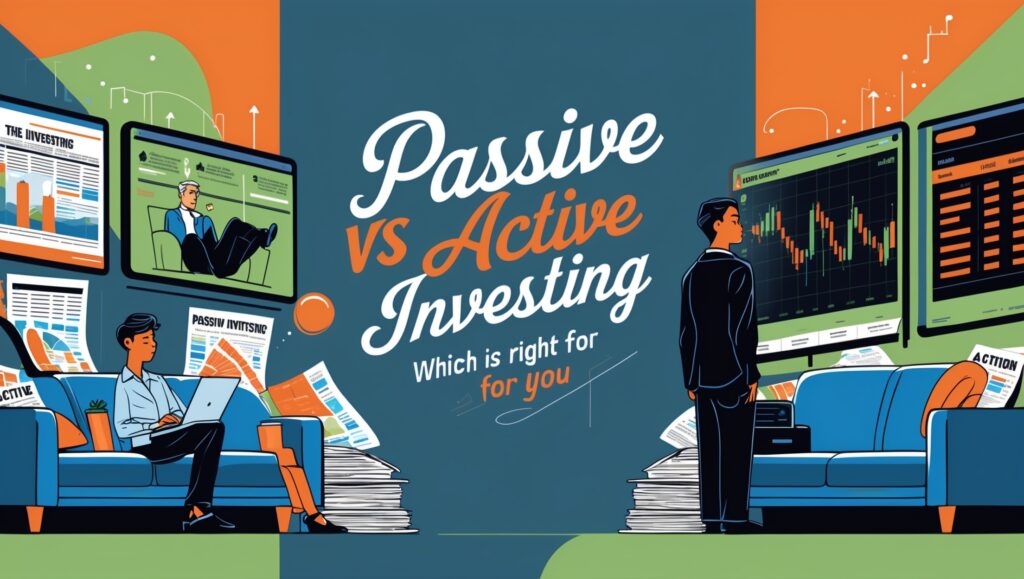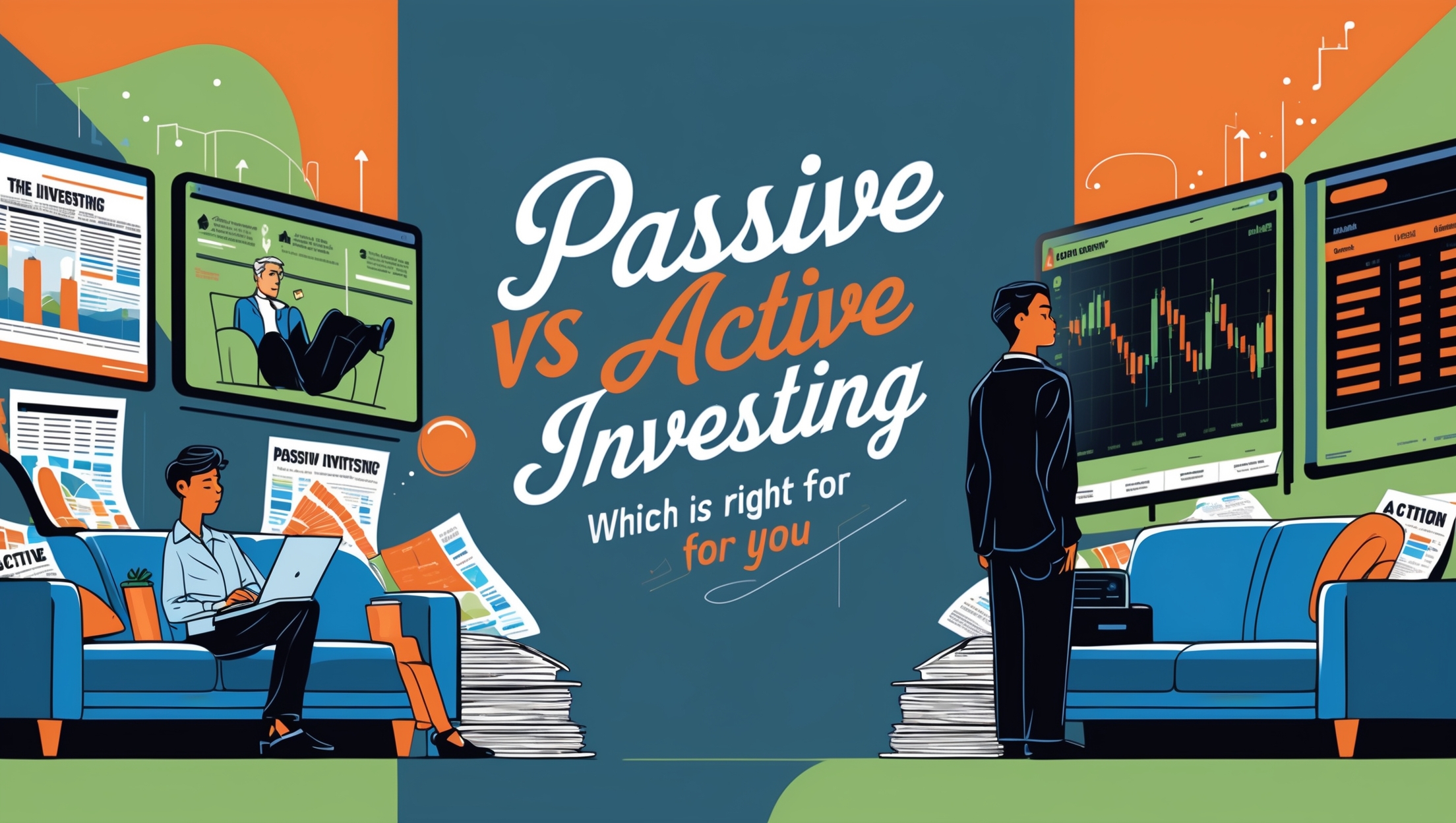Passive vs. Active Investing: Which Is Right for You?
Passive vs. Active Investing: Which Is Right for You?
Discover the difference between passive and active investing, their pros and cons, and how I personally decide which approach fits my goals. Learn strategies that help me build wealth while managing risk effectively.

Table of Contents
When I first got into investing, passive strategies seemed too simple. But I quickly realized their power. Passive investing involves tracking a market index or broad portfolio rather than trying to beat the market.
For me, this means I can invest in index funds or ETFs that reflect a market like the S&P 500. I don’t have to pick individual stocks, and I benefit from the overall market growth.
What Is Active Investing?
Active investing is the opposite. It involves researching and picking stocks or funds to try to outperform the market. Active managers make decisions based on market trends, economic forecasts, or company analysis.
I’ve experimented with active strategies myself. While they can offer higher returns, they also come with higher fees, taxes, and risk.
Pros of Passive Investing
I like passive investing because it’s low-cost, low-maintenance, and historically effective. Some of the benefits I appreciate:
- Low fees – Minimal expenses compared to active funds.
- Diversification – Broad exposure reduces risk.
- Consistency – Historically, passive funds often outperform active funds over the long term.
For me, this approach provides peace of mind and steady growth without constantly monitoring the market.
Pros of Active Investing
Active investing has its advantages too:
- Potential to outperform – Skilled managers may beat the market.
- Flexibility – Managers can react to market changes.
- Focus on niche opportunities – Some sectors or trends can be exploited for growth.
I sometimes allocate a small portion of my portfolio to active strategies to capture upside potential.
Cons of Passive Investing
The main drawbacks I’ve noticed include:
- Limited upside – You match the market, you don’t beat it.
- Exposure to downturns – Passive funds drop when the market drops.
Still, the low cost and simplicity usually outweigh these disadvantages for me.
Cons of Active Investing
I’ve learned that active investing carries risks:
- Higher fees – They eat into your returns.
- Underperformance risk – Many active funds fail to beat their benchmarks after fees.
- Manager dependency – Your results depend heavily on their skill and decisions.
Because of this, I approach active investing cautiously and selectively.
How I Decide Which to Use
I personally use a core-satellite approach. The core of my portfolio is passive, providing stability and low-cost market exposure. The satellite is active, targeting areas I believe have growth potential.
This balance allows me to enjoy steady returns while taking advantage of opportunities without risking my entire portfolio.
The Role of Diversification
Regardless of whether I choose passive or active, diversification is key. Passive funds naturally offer it, while active investing requires careful selection across sectors and asset types.
Diversification has helped me weather downturns without panic and stay invested long enough to capture long-term growth.
Tax Considerations
I also consider taxes. Passive funds often have lower turnover, meaning fewer taxable events. Active funds can generate short-term capital gains, which are taxed at a higher rate.
Combining passive and active strategies with tax-efficient planning helps me maximize after-tax returns over time.
Want My Full Strategy?
If you want to see exactly how I balance passive and active investing to grow wealth and generate consistent income, I explain my system in my ebook: Pay Bills with Stocks.
I break down how I allocate between passive and active funds, manage risk, and structure a portfolio that can cover real-life expenses while compounding wealth.
Final Thoughts
Passive vs. active investing is not an either/or choice. By combining both strategies thoughtfully, I can reduce risk, capture growth, and enjoy steady returns.
If you want a clear, practical guide to implementing this strategy for yourself, check out my full system: Pay Bills with Stocks.
One of the first lessons I learned is that passive investing is ideal for long-term wealth building. I don’t need to constantly monitor the market, and historically, passive funds tend to outperform many active strategies after fees.
I also appreciate how low-cost passive funds allow me to keep more of my money invested. Fees may seem small, but over decades they can add up significantly. Minimizing costs has become a core part of my strategy.
For active investing, I’ve learned the importance of researching fund managers. Some consistently beat benchmarks, but many do not. I only allocate a portion of my portfolio to active strategies when I have confidence in the manager.
Another key insight is that volatility behaves differently between passive and active funds. Passive funds follow market swings, while active funds can fluctuate more dramatically based on manager decisions. Understanding this helps me manage risk and stress.
I also pay attention to asset allocation. By placing the majority of my capital in passive funds and a smaller portion in active opportunities, I create a portfolio that balances stability and growth potential.
I use dollar-cost averaging for both passive and active funds. Investing consistently over time helps me smooth out market fluctuations and reduces the risk of mistiming purchases.
Tracking turnover rates is another important habit. High turnover in active funds can create taxable events and additional costs. Passive funds usually have low turnover, which improves tax efficiency and reduces hidden expenses.
I’ve learned that combining both strategies encourages discipline and patience. Passive funds teach me to stay invested long-term, while active funds require careful research and timing. This balance has made me a more thoughtful investor.
Diversification is another key factor. Passive funds naturally diversify across an index, but active investing requires intentional selection of multiple sectors and asset types to reduce risk.
I also monitor total returns rather than just income or price gains. Combining passive and active strategies, I evaluate the complete picture, including dividends, growth, and fees, to see true portfolio performance.
Using a core-satellite strategy has worked best for me. The core is passive, providing steady growth and broad exposure, while the satellite is active, allowing me to pursue higher returns in specific sectors or trends I understand.
I’ve noticed that tax efficiency matters a lot. Passive funds have low turnover, generating fewer taxable events, while active funds can create short-term gains. Structuring my portfolio with tax efficiency in mind maximizes net returns.
Another tip is to review and rebalance periodically. Even passive funds can drift from your target allocation. I check my portfolio quarterly and make small adjustments to maintain my desired balance.
I also focus on long-term goals. By keeping a majority in passive funds, I reduce stress and avoid reacting to short-term market news. Active funds are a smaller part of my plan, used strategically for growth.
Finally, if you want to see exactly how I combine passive and active investing to generate steady income and grow wealth, I detail my full system in my ebook: Pay Bills with Stocks. It’s the exact method I personally use to balance risk, maximize returns, and build a portfolio that supports real-life expenses.

Stay ahead in the stock market! Subscribe to our newsletter and receive exclusive stock flow reports, trading insights, and actionable tips directly in your inbox. Join thousands of traders who get our updates first.







